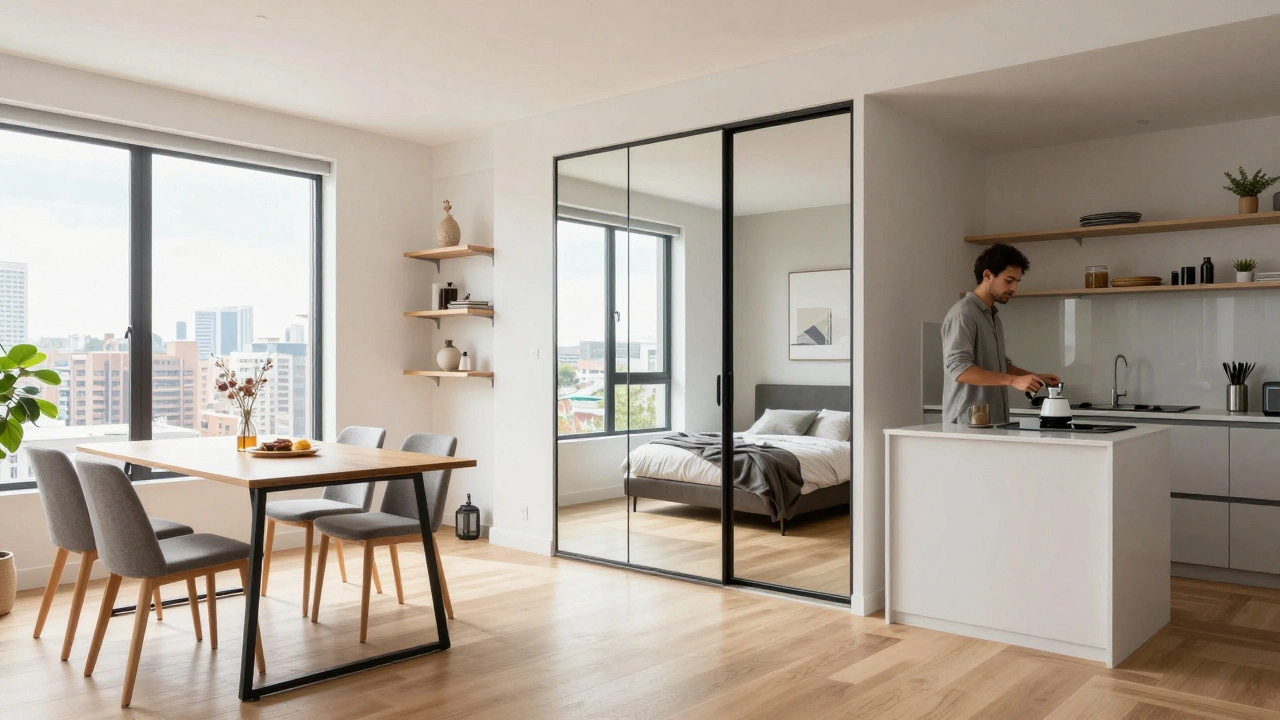The 4 3 2 1 rule sounds like some kind of real estate code, but it’s actually one of the quickest ways to estimate the value of a commercial property plot. If you’re thinking about selling or buying a commercial space—maybe an office lot, retail site, or warehouse plot—this rule gives you a rough price idea without hiring a consultant or spending hours on spreadsheets.
How does it work? The idea is simple: as the size of a plot increases, the price per unit area usually drops. The rule says the front portion of a property is the most valuable, and as you move further back, each piece is worth less. Basically, if you cut the plot into four equal strips—front to back—the first strip is worth four units, the second three, the third two, and the back strip just one.
Why does this matter? In fast-moving commercial markets, you don’t always have time for complicated maths. Investors, brokers, and even property owners use the 4 3 2 1 rule on the fly when rough calculations are needed—like split-second price negotiations, or when sizing up a property during a site visit.
- What Is the 4 3 2 1 Rule and Where Did It Come From?
- How the 4 3 2 1 Rule Works for Property Valuation
- Real-World Scenarios and Pitfalls to Avoid
- Practical Tips for Using the 4 3 2 1 Rule When Selling
What Is the 4 3 2 1 Rule and Where Did It Come From?
The 4 3 2 1 rule is a shortcut that people working in commercial real estate use to work out land values quickly. It's not a legal code or some complicated finance trick—it's actually from the old street markets, especially in cities like Mumbai and Delhi, where land demanded quick, street-smart calculations. Picture a plot divided lengthwise into four equal slices from the road to the back fence. The closest strip to the street is the priciest, because foot traffic, visibility, and accessibility matter the most for businesses. The farther you move back, the value per square foot drops.
Here's the basic idea:
- The first (front) quarter of the land: Worth four parts
- The next quarter: Three parts
- The third quarter: Two parts
- The last (back) quarter: Just one part
Add all those parts (4 + 3 + 2 + 1 = 10) and you get a total that you can divide the property's total price by. So, if you know the front strip's value, you can estimate what the rest of the plot is worth. It lets you dig into price discussions right at the negotiation table, especially for retail sites, main road offices, and any commercial property where frontage is king.
This rule took off because traditional land pricing was too slow for fast deals and site flips. You still see it used today in surveys and government guidance documents across India, and even in property workshops teaching newbies how to value commercial property on the fly. In fact, government land pricing circulars in places like Maharashtra still reference this shortcut in urban plot calculations.
Want a quick look at how it breaks down? Check out this simple table:
| Plot Strip | Relative Value |
|---|---|
| Front (1st quarter) | 4 parts |
| Second | 3 parts |
| Third | 2 parts |
| Back (last quarter) | 1 part |
The whole thing keeps math easy, helps avoid overpaying for less prime land, and gives you solid ground in any commercial property selling conversation.
How the 4 3 2 1 Rule Works for Property Valuation
The 4 3 2 1 rule is built around a simple truth in commercial real estate: the street-facing sections of a property get way more attention and command higher prices. The further you move in, the less value you get per square foot. Why does this happen? Easy access, visibility, and foot traffic are king in commercial spaces. Businesses pay more to be up front—think of that coffee shop right by a busy street versus one hidden at the back of a business park.
Here’s how the math shakes out. You split the plot into four equal strips from the street to the rear. Then you assign value units like this:
- First (front) strip: 4 units per square foot
- Second strip: 3 units per square foot
- Third strip: 2 units per square foot
- Fourth (rear) strip: 1 unit per square foot
Add those up, and you have 10 units total for the whole property. That’s your baseline. Now let’s say a commercial plot is 4,000 square feet, broken into four stripes of 1,000 sq ft each, and you know the market front price is Rs.10,000 per sq ft. Using the rule:
- 1,000 sq ft x Rs.10,000 x 4 (front) = Rs.40,000,000
- 1,000 sq ft x Rs.10,000 x 3 (second) = Rs.30,000,000
- 1,000 sq ft x Rs.10,000 x 2 (third) = Rs.20,000,000
- 1,000 sq ft x Rs.10,000 x 1 (rear) = Rs.10,000,000
The total value comes out to Rs.1 crore (Rs.100,000,000). But to get the true average price per sq ft for the full plot, just divide the total by 4,000 sq ft. That way, you aren’t overpricing the back or underpricing the front—you get a balanced market rate.
Here’s how the numbers compare as you move through the property:
| Section | Strip Value Multiplier | Price for 1,000 sq ft at Rs.10,000 |
|---|---|---|
| Front (1st) | 4 | Rs.40,00,000 |
| Second | 3 | Rs.30,00,000 |
| Third | 2 | Rs.20,00,000 |
| Rear (4th) | 1 | Rs.10,00,000 |
The thing to remember with the 4 3 2 1 rule is that it’s not an exact science. It gives you a ballpark number fast, especially handy when you’re sizing up plots or in a heated negotiation. Also, it helps avoid common blunders, like charging one flat rate for the whole area (which often scares off smart buyers or leaves money on the table).
This rule is popular in older city layouts and high-traffic commercial zones, especially in markets like Mumbai, Delhi, and Bangalore, where plot depth and street visibility can make or break a deal. Use it as a guide, but always double-check with recent sales or a quick call to a local agent for backup.

Real-World Scenarios and Pitfalls to Avoid
Let’s make this real. Imagine you’re selling a commercial property right on a busy street—say, a plot that's 80 meters deep. Buyers often use the 4 3 2 1 rule to break down the value: the first 20 meters (closest to the road) get priced the highest, and it drops with each next section. That makes sense—shops in front catch all the action, while the stuff in back mostly ends up as storage or parking. But things aren’t always this neat.
Here’s where folks get tripped up. Lots get weird shapes. Maybe the back of your plot touches another busy road, or a local regulation blocks commercial use on the last strip. That messes with the standard price drop the 4 3 2 1 rule assumes. Sometimes, buyers rely so much on this shortcut, they miss chances for smarter deals or overpay for worthless space.
In Mumbai’s Andheri business district, a 2022 survey by local brokers showed about 18% of commercial sellers lowballed their property by strictly sticking to this rule—didn’t consider street exposure or zoning that could boost back-lot values. That’s actual money left on the table.
Another common trap: assuming all cities work the same. In tech parks around Bangalore, even deep plots command high prices if they’re close to big companies or metro stations. Suddenly, the "back is cheap" logic falls flat. There’s a lesson hiding here: context rules, not just rules of thumb.
"The 4 3 2 1 rule is just a starting point. Experienced agents always adjust for location and local demand, or else sellers could lose up to 20% on prime plots." – Amit Mehra, Senior Analyst, CRE Insights
To avoid rookie mistakes when applying the 4 3 2 1 rule in commercial real estate:
- Do a walk-through. See if there’s access, visibility, or features in the back that change value.
- Check local zoning. Weird rules can make the rear more valuable or worth almost nothing.
- Talk to other sellers and brokers for real-time price comparisons.
- Adjust estimates if the shape is L-shaped, oddly wide, or split by driveways.
- Don’t skip on proper surveys—if not for yourself, the buyer will do it and renegotiate.
Here’s a quick look at how a typical deal can skew with and without checks:
| Scenario | Deal Value (Based on 4 3 2 1) | Reality Check Value |
|---|---|---|
| Standard plot, no zoning restrictions | ₹2 Cr | ₹2.05 Cr |
| Back of plot abutting commercial lane | ₹1.9 Cr | ₹2.2 Cr |
| Back portion unusable due to local law | ₹2 Cr | ₹1.7 Cr |
The takeaway? Use the 4 3 2 1 rule as a rough guide—but sanity-check everything before you shake hands on a commercial property sale.
Practical Tips for Using the 4 3 2 1 Rule When Selling
Putting the 4 3 2 1 rule to work can help you sell commercial real estate faster and more confidently. Here’s how to squeeze the most value out of this method:
- Measure the plot accurately. The whole point of the 4 3 2 1 rule is to split the land evenly front to back. Get the measurements right—don’t just estimate it by eye. This avoids errors in pricing and helps keep negotiations honest.
- Apply local price per unit. Start with the market rate for the most valuable front strip; that’s your "4". Define this using local comps or rates from nearby properties recently sold or listed. The back strips follow as 3x, 2x, and 1x, so base your math on real data, not rough ideas.
- Show the logic to buyers. Buyers often challenge your price. Use the rule in presentations or during walk-throughs, splitting up the property visually or with simple charts. When buyers actually see how the value spreads, it’s easier for them to understand (and accept) your price.
- Don’t ignore shape and access. The rule works best for standard rectangular plots. If your site is uneven or narrow, adjust accordingly—it doesn’t make sense to pretend all plots are created equal. Business owners, for example, pay premiums for wide entries or great road visibility, so use that to argue for a higher front strip value.
- Use a backup method. While the 4 3 2 1 rule is great for a quick estimate, double-check with another method, like a formal appraiser’s opinion or sales comparison. Many agents use both to back up their asking price, especially in competitive commercial property selling markets.
Feeling nervous about negotiating? Here’s a sample table showing how you might break down a 100-foot-deep property if the front strip fetches $400 per square foot:
| Strip | Multiplier | Width (ft) | Price per unit ($/sq ft) |
|---|---|---|---|
| Front (1st 25 ft) | 4 | 25 | 400 |
| Second (next 25 ft) | 3 | 25 | 300 |
| Third (next 25 ft) | 2 | 25 | 200 |
| Back (last 25 ft) | 1 | 25 | 100 |
Using this layout, you get a clear map of each section’s value. Use it as a bargaining chip or a reference point during negotiations. Being specific—and not just tossing numbers—builds buyer trust and can lead to better offers. That’s how smart real estate investing and selling works these days.





